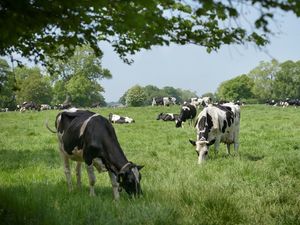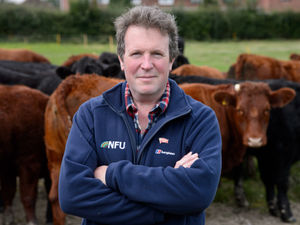Shropshire Farming Talk: Reduce the grass staggers threat this spring
Estimations suggest that one per cent of cattle in the UK will experience clinical grass staggers, with up to 30 per cent of all clinical cases resulting in death and significant direct losses.

Grass staggers, otherwise known as grass tetany or hypomagnesaemia, are a very real threat for suckler and dairy cows at turnout. It is easily managed by assessing and managing the on-farm risks and considering options as the rapid flush in grass growth increases.
Grass staggers are defined as a deficiency of available dietary magnesium. Magnesium is a key macro-nutrient in the diet and is essential for bone growth and maintenance, nervous system function and also as an aid to fibre digestion in the rumen.
Rapidly growing spring grass typically has a low magnesium content (0.1 to 0.2 per cent in dry matter) which, combined with its low dry matter and rapid transit through the rumen can result in very low levels of magnesium absorption into the animal’s bloodstream.
Magnesium is predominantly stored in the bones of the animal and consequently is not readily available when dietary supply is compromised. Livestock rely on daily magnesium supplementation to maintain adequate blood magnesium levels at times when risk is increased such as spring, and autumn.
To help alleviate the risk of grass staggers, long fibre should always be available in the form of hay or silage, to help slow the transition of wet spring grass through the rumen. It is also essential to maintain dietary energy levels (notably starch and sugar) to help prevent excess rumen ammonia.

Dry matter intake needs to be maintained, whilst an adequate supply of minerals, trace elements and vitamins, including a suitable supplementary sodium (salt) source is also essential to re-address the sodium to potassium ratio. Finally, and most importantly, it is vital to ensure livestock has daily access to a suitable magnesium supplement.
Magnesium is typically an unpalatable mineral, so presenting it in a molassed free-access lick, ensures livestock have a reliable supplement to complement their diet.
Spring magnesium molassed mineral licks, from NWF, contains 15 per cent magnesium along with a range of minerals, vitamins and trace elements, including sodium. It is suitable for feeding to breeding and lactating cows at risk of grass staggers to help supplement grazing at this time of year.
Additional magnesium can also be supplied within compound feeds and blends and through addition powdered minerals when formulated by a nutritionist.
Ideally, magnesium supplements should be offered up to two weeks pre-turnout to better prepare stock for changes. Then, by turnout, they are familiar with the supplements and are not faced with a deficit.
Adam Clay, NWF Technical Director




